Crickets and Katydids Biology
Order Orthoptera, Suborder Ensifera
- This page contains pictures and information about Crickets and Katydids Biology that we found in the Brisbane area, Queensland, Australia.

- Crickets and katydids are in insect Order Orthoptera, Suborder Ensifera. They are among the most commonly seen insects. Their size ranges from 5mm to 100mm. They usually have very long hair-like antenna, usually longer than their body length. Most of them have the hind legs highly developed, much stronger and larger than the front two pairs of legs. They are good in jumping.



- The adult insects have four wings. The front
wings, knows as tegmina, are tough and narrow comparing with the hind wings.
At rest, the hind wings folded like a fans, covered and protected by the
tegmina. The flight is mainly achieved by the broadly opened membranous hind
wings and the tegmina give only little help.
- Details about insect structure can be found in this page.



- Katydids' eggs
- Eggs are ovoid to cylindrical in shape. They are usually laid on vegetation in groups.
- Crickets and
Katydids are incomplete metamorphosis.
Their young, the nymphs, look much
the same as their adults excepts smaller and wingless. Later instars have
wing buds but still cannot fly.
- Many Crickets and Katydids species sing by stridulation. Males use sound to attract females. For most species sound is produced by rubbing modified portions of the forewings together. A good example of how cricket makes those sound can be found in this page.
- We found a female Gum-leaf Katydid feeding on a gum tree at night in Wishart bushland during late summer 2001. We took it home for a closer observations. After two days, she started to lay eggs. Totally she laid three batches of eggs before we put it back to the bush. The pictures below showing she was laying the first batch of eggs on the edge of a gum tree leaf.



- The katydid laid ten eggs along the edge of a gum tree leaf. The eggs were dark brown in colour, in oval disk shape with 4mm in length. The eggs looked like plant seeds. The katydid lay totally three batches (10, 8, 9 in qty) of eggs every alternative night.
- The following pictures show the katydid laying eggs on gum stem.



- She first cuts an opening on the stem using her sharp ovipositor. Into which she lays the hard, black and disk-like eggs.


- She carefully glues their eggs in row, then she repeats the whole procedure for another egg.
- We noticed one thing quite interesting. We kept the katydid openly in a corner of our room on a branch of gum leaves. The katydid had no problem on staying there for the whole day. But every time after she laid her eggs, she had the very strong intention to move to another location, even if we tried to stop it. After it flied to the other corner of our room, we put it back to the same branch of leave, then it stayed there comfortably until laying the next batch of eggs. We think this could be the instinct of the katydid that naturally selected to avoid too many eggs laid at the same location.
- The female lay eggs on leafs and stems. Their ovipositor are short when compare with other species of katydids. But it is strong and sharp, as shown in the above picture. It is used for cutting the surface of the leaf or stem, into which the hard, black and disk-like eggs are laid. Then the female carefully glue their eggs in row.



- We found some katydid eggs in the wild on mid winter season.

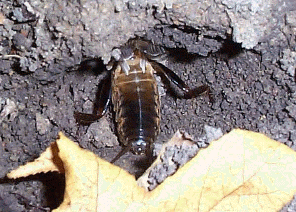
- Mole crickets make sound by stridulation. Males produce songs and build burrows to amplify their love song to attracted females. Females also stridulate but their calls are lower and most often they do it to protect their burrows. Some reference books suggested that females response to males' love song also by stridulation as well.
- In mating season, female mole crickets look for males to mate. The males play their love songs at the entry of their burrow. It is believed that females, by judging the sound, can determine the health of the male and the quality of the nest that the male prepared. It seems that the females preferred the wet nest and usually the males will only play their love songs in the wet evening. In a summer evening, if there is rain during the day, we will always hear the loud mole cricket sound everywhere in Brisbane. Sometime We can trigger the mole cricket songs by watering the garden just before evening.
 Non- regular pattern, recorded at the beginning of the song, 10 sec.
Non- regular pattern, recorded at the beginning of the song, 10 sec. Click here to hear calling song,
5 sec.
Click here to hear calling song,
5 sec.  Regular pattern song, 10 sec. The
mole cricket play it for 30min.
Regular pattern song, 10 sec. The
mole cricket play it for 30min.- Love songs from male crickets are a series of loud, deep-toned chirps, like crick-crick, crick-crick, crick-crick repeated regularly about two times per second. They only play for a short periods of time. They start playing when the sky turns dark and end singing when the sky is dark completely, for about 30 minutes. They do not play songs if the soil is dry. The shape of their burrow is believed to help amplify their songs. It is difficult to locate them by their songs even if you are within a meter from them. If you come a bit closer, they will stop playing. They may resume the song after a minute or so if no more disturbance. Those songs are so loud that you may think that they are the calls from frogs.
- Most field crickets and katydids play their love songs by rubbing their left forewing with their right forewing. Common Mole Cricket play their love songs in a sightly different way. The songs from field crickets and katydids usually consist of a carrier frequency and then modulated with pulses. This is generated by rubbing the forewings, each pulse correspond to a stroke of rubbing forewings. The songs from Mole Cricket are characteristic by the addition series of chirps, the further modulation on the pulses and carrier frequency. The chirps are generated by the forewings touching the burrow ceiling. Details of carrier frequency, pulses and chirps are explained in the following section.
- With the Mole Cricket's forewings under the microscope, we can see the file vein with stridulatory teeth on left forewing and the peg vein on the right forewing. The file vein is on the wing bottom while the peg is on wing top, and they are facing each other. By a stroke of rubbing both forewings, this generate one pulse of modulated carrier frequency.
Laying Eggs
Because they lay eggs on plants and their eggs look like plants materials, katydids are sometimes distributed by nursery stock.
Katydid's front leg
Notice the openings on its front legs, known as tympana, which is the sound receptors. They are the organs function like our ears, are to hear. The female katydid uses them to locate the males by their love songs.

Let's have a closer look of the katydid front leg. The drawing shows the foreleg of the katydid, which is the typical example of insect legs except there is the special organ tympana. The tympana is only found on katydids' and crickets' forelegs, and not on other legs nor on any legs of other insects.
All insects have three pairs of legs. These legs can be variously modified depending on the type of insect. Basically each leg has 6 segments. The coxa connects the leg to the thorax. Leading outward are the segments: trochanter, femur, tibia, and tarsus. The tarsus comprised of 3-5 very small segments. At the end of the last tiny segment is the claw. There are usually spines on the tibia. The tarsomere on the tarsus is the part in contact with the ground.
For more information on insect body parts, please see the Insect Scientific Page.
The Loud Calling Songs
Love songs from male crickets are a series of loud, deep tones repeated regularly about two times per second. But it is not quite regular when start. The mole cricket may have to fine tune his song by trying different positions to get the best sound quality. Press the following buttons to hear the different.
Rubbing Forewings and Touching Ceiling
-
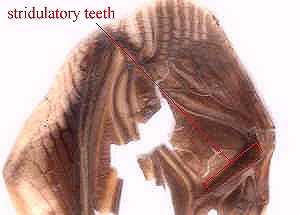
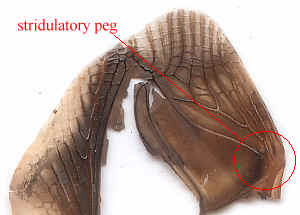
- First picture shows the bottom view of the left forewing, where the file vein with stridulatory teeth locate. The second picture shows the top view the right forewing and the location of the peg.
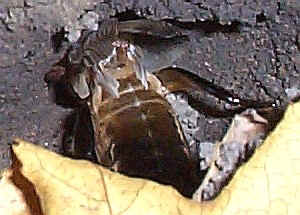


- The Mole Cricket playing the love song at the entrance of its burrow. When a stroke of opening and closing of its forewings, this generate one pulse of carrier frequency. The frequency depend on the number of teeth on the teeth vein and the speed of moving the forewings.
- Besides the pulses, the songs from Mole Cricket are characteristic by the addition series of chirps, the further modulation on the pulses and carrier frequency. The chirps are generated by the forewings touching the burrow ceiling. The male mole cricket plays the love song standing at the entrance of his burrow and facing inwards. By rubbing two forewings together, the mole cricket generates the pulses. By touching the forewings to the ceiling, the mole cricket generates the chirps.
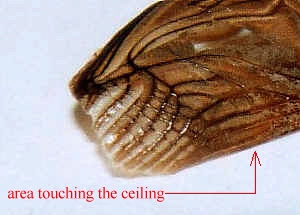

- The first picture shows the left forewing of a male Mole Cricket. Notice the area which in contact with the ceiling, it had been worn out a bit, showing that part was rubbed with the ceiling. The second picture shows when the Mole Cricket rubbing its forewings, with the wings in contact with the burrow ceiling, This enhance the vibration transmitted to the hard shell, which join between the forewings and the abdomen.
- By the inspection of the male Mole Cricket specimen, we found that 2/3 of it abdomen under the wing's base is hollow. There is a hard shell that connects between the wing's base to the hollow cavity. If the Mole Cricket rubs its forewings WITHOUT touching the ceiling, the sound generate is comparatively small. If the Mole Cricket rubs its forewings AND touching the ceiling, which enforce the transmission of vibrations to the abdomen. The empty space inside the abdomen acts as the resonance chamber for the 1st amplification of the sound. By touching the forewings to the burrow ceiling in a constant interval, this generate the chirps.
- Three Stages of Amplification
- The Mole Cricket Songs are so loud because there are three stages of amplification. Field crickets and katydids rub their wings and amplify the sound by the wings surface. The loudness is beyond compare with Mole Crickets' songs.
- As mentioned above, by transmitting the vibrations to the empty space of the abdomen , the hollow abdomen is used as the resonance chamber for the 1st amplification of the sound.
- Mole Crickets build their nest chambers with volume, i.e., the resonance frequency close to the pitch of the love song they play. The thorax of the mole cricket is just like a plug at the entrance of its burrow. By standing inside or outside a bit, the mole cricket can fine tune the volume of the chamber, i.e. the resonance frequency. Then the sound is further in resonance with their burrow chamber. This is the 2nd amplification stage of the love song.
- Mole crickets build the entrance of their burrows in horn shaped. This acts as the third stages of the amplification. The horn also direct the sound to improve the efficiency.
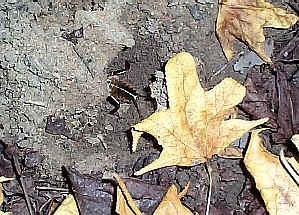

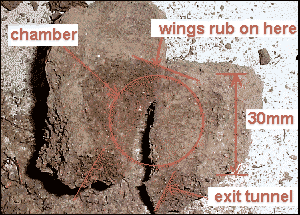
- The mole cricket playing their love songs by its forewings rubbing together and touching the ceiling of the burrow. The second picture shows the three stages of amplification - the hollow abdomen, the resonance chamber and the horn shape entrance.
- We have studied a mole cricket calling site and opened the chamber. The left picture shows the horn and the entrance. The right picture shows the internal of the chamber.
- Love songs from male crickets are a series of loud, deep tones repeated regularly. The sound consists of carrier frequency, pluses and chirps. It is worth to go back and listen again.
- Analyse the Sound Waveforms
- The Mole Cricket Song repeated regularly in a pattern. To know exactly how Mole Cricket play the song we need an expensive high speed camera, and a bit of luck. The Mole Cricket may not be willing to play under the heavy equipment set up. However, by carefully analyse the sound waveforms patterns and what we have observed above, we can reasonably describe how the Mole Cricket play the song.
- We recorded the sound by a hand-held tape recorder 200mm - 300mm above the Mole Cricket. Then we play back to the PC sound card via a condenser microphone and recorded by the 'Sound Recorder' program within Windows98. We analysed the sound waveforms using a free software 'Cool Edit' downloaded from http://www.syntrillium.com.
- The sound is a series of chirps, with about 5 chirps per second. Within each chirp, there is seven pulses. Within each pulse, there is the 2.1KHz carrier frequency.
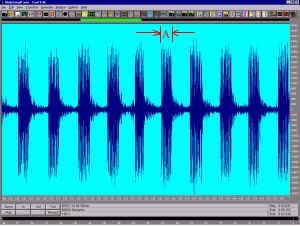
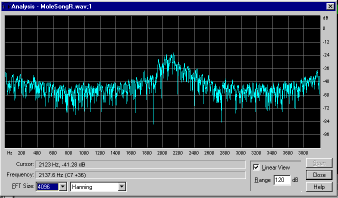
- Waveform 1. In the waveform picture, 'A' is one chirp. The picture shows two second, i.e., ten chirps of the sound. The second picture shows the frequency spectrum of the sound, indicates the base frequency is 2.1KHz.

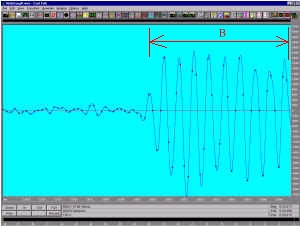

- Waveform 2. The chirp 'A', with seven pulse 'B'. The pulse rate is about 90 pulses per second.
- Waveform 3. One of the seven pulse 'B', and the 2.1KHz base frequency.
- Waveform 4. The picture shows the waveform at the end of a chirp. Notice that the last pulse with the amplitude about 1/4 of the normal pulses. This is sometime happen at the last pulse of the chirp. I think this is due to the Mole Cricket low down its wings too early, i.e., rubbing its wings without touching the ceiling. This made the amplitude significantly lower.
- Now we can summarize what we found and describe how the Mole Cricket generate its love song. The Mole Cricket rubs its forewings in a constant speed. Each stroke generates a pulse of carrier frequency 2.1KHz. The Mole Cricket rubs its wings at the rate of 90 cycles per second. This generates the pulses within the chirp. The Mole Cricket move its whole body slightly up and down five times a second, so it forewings in contact with the ceiling five times a second and generate the chirps pattern. The whole process make the crick-crick, crick-crick sound.
Questions for Discussion
Why it is the male katydid who made the calling, and not the female?

- Evolution theory would predict that if there were any risks involved then the sex offering the higher investment should take fewer risks. Since eggs are more expensive than sperms, the facts that the risk of detection by predators of calling individuals, males are more likely to call than females.
- Reference:
- 1. Insects of Australia, CSIRO, Division of Entomology, Melbourne University Press, 2nd Edition 1991, pp 369.
- 2. Insects of Australia and New Zealand - R. J. Tillyard, Angus & Robertson, Ltd, Sydney, 1926, p94.
- 3. Northern Territory Insects, A Comprehensive Guide CD - Graham Brown, 2009.
- 4. A Guide to the Katydids of Australia - David Rentz, CSIRO PUBLISHING, June 2010.
